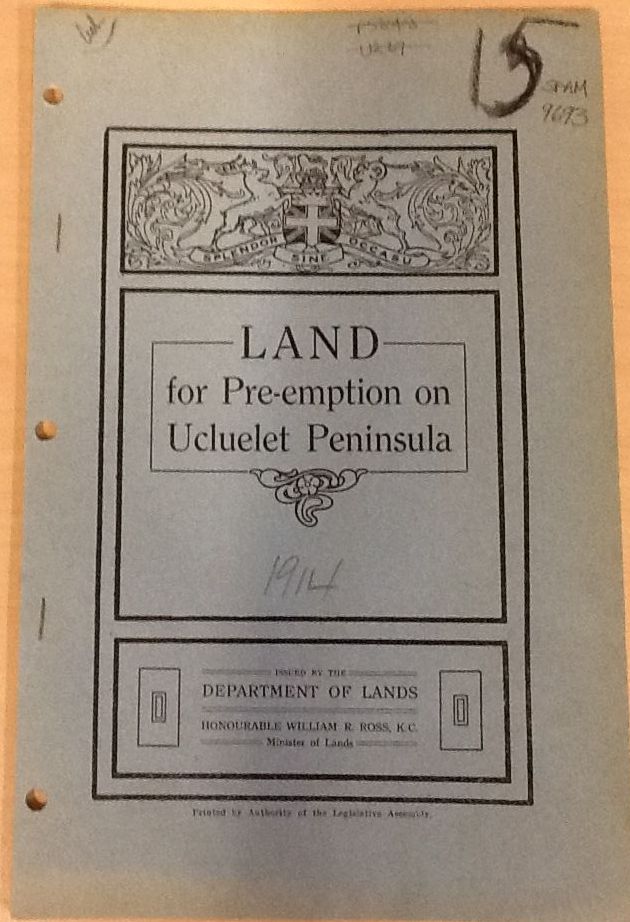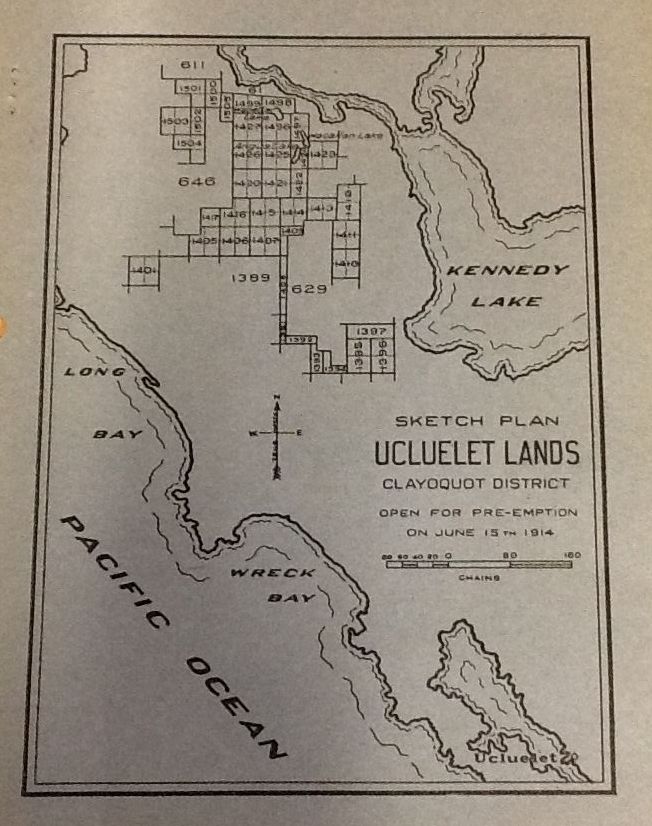May 26th, 2012 by sromkey | No Comments »
This post is part of a series which uses the room names in the Irving K. Barber Learning Centre to explore places in B.C. and the collections at Rare Books and Special Collections. Our featured place for this post is Ucluelet, located on the west coast of Vancouver Island. Ucluelet is located on the edge of Barkley Sound and is known for being at the southern end of beautiful Long Beach, which is in between there and Tofino. The Ucluelet area is home to the Yuułuʔiłʔatḥ First Nation.
The resource from our collections we would like to feature from Ucluelet is a pamphlet describing land available for preemption in 1914:

Land for pre-emption on Ucluelet Peninsula, 1914
This pamphlet was issued by the B.C. Minister of Lands (William R. Ross) and describes the geography, climate and settlers of the Ucluelet Peninsula. It explains that 40-acre lots would become available for preemption on June 15, 1914 and also provides a map of the lots available:

Sketch plan, Ucluelet lands
As explained by the B.C. Archives, the preemption of lands was allowed so that individuals and corporations could acquire crown land, with the idea that they would cultivate it or otherwise “improve” it. This was in practice from 1859 until 1970 in B.C. The B.C. Archives link above describes how to search for a preemption record; they are now often used as genealogical sources. You can search an online database by name, district, date and other parameters. For example, you could search for lands granted in the Clayoquot District (which would include the lots described in this pamphlet in Ucluelet) from June 15 1914 till the end of that year to get a sense of how many of these lots were preempted, and to whom.
This pamphlet is part of our SPAM (Special Collections Pamphlet collection) and can be found by searching in the Library Catalogue. For information on this collection and other ephemera in our collections, check out our Ephemera Research Guide.
In the Barber Centre, the Ucluelet Room is room 158, a classroom on the first floor.
Posted in Collections, Research and learning | No Comments »
May 4th, 2012 by sromkey | 1 Comment »
We were shocked and saddened this week to learn of the cancellation of the National Archival Development Program. This is in addition to a major round of cuts at Library and Archives Canada, which was the funding source of the program.
The funding is used by the Archives Association of British Columbia, as it is in other provinces and territories by their respective archival organizations, to maintain our provincial database of archival holdings, MemoryBC, and to employ a professional archivist and a professional conservator to provide advice to archival institutions and archivists when needed. It also provides professional development opportunities for archivists, so that we can continue to learn to serve our patrons and our collections better. UBC Rare Books and Special Collections has very frequently taken advantage of these opportunities; for example, this program was used to help develop a preservation plan for the Chung Collection, a declared national treasure and one of our most frequently used collections.
This same pot of funds was used to maintain the national archival database, Archives Canada. This database brings together archival descriptions from institutions across Canada. There is no other “one stop shop” for searching archives across the country, making this and provincial/territorial equivalents like MemoryBC absolutely crucial research tools for everybody who uses archives. In our reference and teaching activities here at RBSC, we are constantly referring researchers to these resources.

Images of Jack Shadbolt mural, preserved and catalogued using NADP funds
The other arm of this funding was used to provide matching grants to archival institutions to preserve, catalogue and disseminate our archival collections. In recent years, this funding was used by Rare Books and Special Collections to catalogue and make available the Mike Apsey fonds, the Council of Forest Industries fonds, and the Red Cedar Shingle and Handsplit Shake Bureau fonds (all in our recently created Forest History research guide); the Jack and Doris Shadbolt fonds (featured in our British Columbian Art and Artists research guide); and the Rosemary Brown fonds (the archives of the first black female member of a Canadian parliamentary body). Just from these examples, it is easy to see that this funding is crucial in helping the Canadian public gain access to records ranging from industry, to politics, to the environment, to the arts.

Advertisement from the Red Cedar and Handsplit Shake Bureau fonds, preserved and catalogued using NADP funds
The National Archival Development Program was administered by the Canadian Council of Archives. If you would like to learn more, there is a Call to Action on their website.
Posted in Collections, Research and learning, Services | 1 Comment »




